Wilcoxon Signed-Rank Test using SPSS
Introduction
The Wilcoxon signed-rank test is the nonparametric test equivalent to the dependent t-test. As the Wilcoxon signed-ranks test does not assume normality in the data, it can be used when this assumption has been violated and the use of the dependent t-test is inappropriate. It is used to compare two sets of scores that come from the same participants. This can occur when we wish to investigate any change in scores from one time point to another, or when individuals are subjected to more than one condition. For example, you could use a Wilcoxon signed-rank test to understand whether there was a difference in smokers' daily cigarette consumption before and after a 6 week hypnotherapy programme (i.e., your dependent variable would be "daily cigarette consumption", and your two related groups would be the cigarette consumption values "before" and "after" the hypnotherapy programme).This "quick start" guide shows you how to carry out a Wilcoxon signed-rank test using SPSS, as well as interpret and report the results from this test. However, before we introduce you to this procedure, you need to understand the different assumptions that your data must meet in order for a Wilcoxon signed-rank test to give you a valid result. We discuss these assumptions next.
SPSStop ^
Assumptions
A Wilcoxon signed-rank test is only appropriate where the following two assumptions are met:- Assumption #1: Your dependent variable should be measured at the ordinal orcontinuous level. Examples of ordinal variables include Likert scales (e.g., a 7-point scale from strongly agree through to strongly disagree), amongst other ways of ranking categories (e.g., a 5-point scale explaining how much a customer liked a product, ranging from "Not very much" to "Yes, a lot"). Examples of continuous variables (i.e., interval or ratio variables) include revision time (measured in hours), intelligence (measured using IQ score), exam performance (measured from 0 to 100), weight (measured in kg), and so forth. You can learn more about ordinal and continuous variables in our article: Types of Variable.
- Assumption #2: Your independent variable should consist of two categorical,"related groups" or "matched pairs". "Related groups" indicates that the same subjects are present in both groups. The reason that it is possible to have the same subjects in each group is because each subject has been measured on two occasions on the same dependent variable. For example, you might have measured 10 individuals' performance in a spelling test (the dependent variable) before and after they underwent a new form of computerized teaching method to improve spelling. You would like to know if the computer training improved their spelling performance. The first related group consists of the subjects at the beginning (prior to) the computerized spelling training and the second related group consists of the same subjects, but now at the end of the computerized training. The Wilcoxon signed-rank test can also be used to compare different subjects, but this does not happen very often. Nonetheless, to learn more about the different study designs you use with a Wilcoxon signed-rank test, see our enhanced Wilcoxon signed-rank test guide.
SPSStop ^
Example
A pain researcher is interested in finding methods to reduce lower back pain in individuals without having to use drugs. The researcher thinks that having acupuncture in the lower back might reduce back pain. To investigate this, the researcher recruits 25 participants to their study. At the beginning of the study, the researcher asks the participants to rate their back pain on a scale of 1 to 10, with 10 indicating the greatest level of pain. After 4 weeks of twice weekly acupuncture, the participants are asked again to indicate their level of back pain on a scale of 1 to 10, with 10 indicating the greatest level of pain. The researcher wishes to understand whether the participants' pain levels changed after they had undergone the acupuncture, so a Wilcoxon signed-rank test is run.In our enhanced Wilcoxon signed-rank test guide, we show you how to correctly enter data in SPSS to run a Wilcoxon signed-rank test. You can learn about our enhanced data setup content here. Alternately, we have a generic, "quick start" guide to show you how to enter data into SPSS, available here. In our enhanced Wilcoxon signed-rank test guide, we also explain how to deal with missing values in your data set (e.g., if a participant completed a pre-test, but failed to turn up to the post-test). In the next section, we take you through the Wilcoxon signed-rank test procedure using SPSS.
SPSStop ^
Test Procedure in SPSS
The six steps below show you how to analyse your data using a Wilcoxon signed-rank test in SPSS. At the end of these six steps, we show you how to interpret the results from this test.- Click Analyze > Nonparametric Tests > Legacy Dialogs > 2 Related Samples... on the top menu, as shown below:
Note: For older versions of SPSS (17 and below), click Analyze > Nonparametric Tests > Related Samples....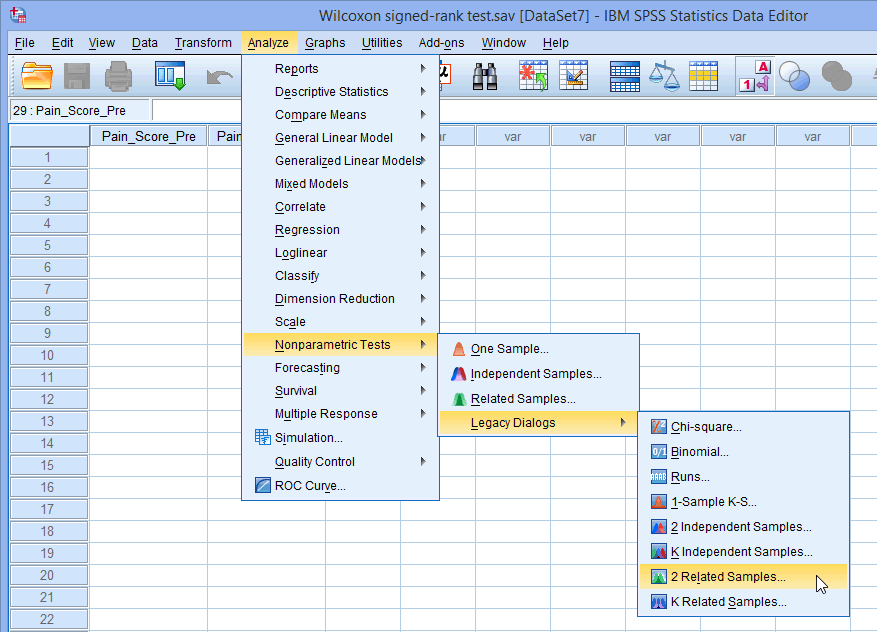
Published with written permission from SPSS, IBM Corporation. - You will be presented with the Two-Related-Samples Tests dialogue box, as shown below:
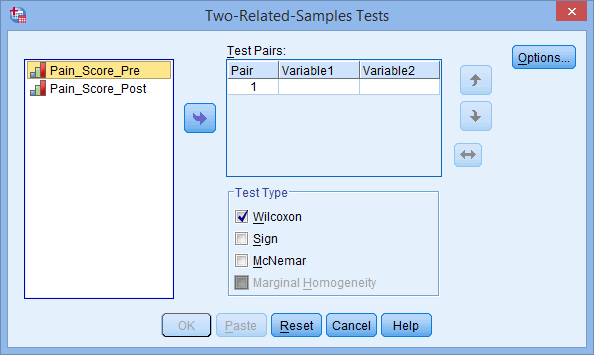
Published with written permission from SPSS, IBM Corporation. - Transfer the variables you are interested in analysing into the Test Pairs: box. In our example, we need to transfer the variables Pain_Score_Pre andPain_Score_Post, which represent the Pain Scores before and after the acupuncture intervention, respectively. There are two ways to do this. You can either: (1) highlight both variables (use the cursor and hold down the shift key), and then press the
 button; or (2) drag-and-drop each variable into the boxes. Make sure that the Wilcoxon checkbox is ticked in the –Test Type– box. You will end up with a screen similar to the one below:
button; or (2) drag-and-drop each variable into the boxes. Make sure that the Wilcoxon checkbox is ticked in the –Test Type– box. You will end up with a screen similar to the one below:
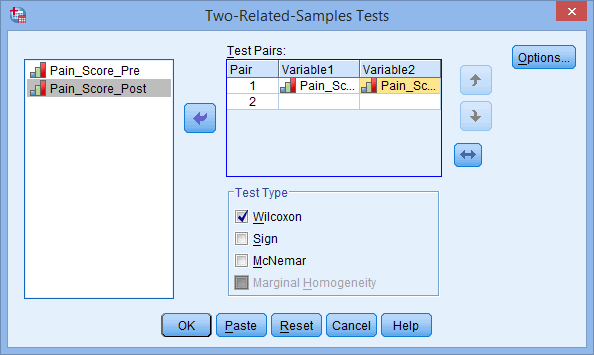
Published with written permission from SPSS, IBM Corporation.Note: button shifts the pair of variables you have highlighted down one level.
button shifts the pair of variables you have highlighted down one level. button shifts the pair of variables you have highlighted up one level.
button shifts the pair of variables you have highlighted up one level. button shifts the order of the variables with a variable pair.
button shifts the order of the variables with a variable pair. - If you want to generate descriptives or quartiles for your variables, select them by clicking the
 button and ticking the Descriptive and Quartiles checkboxes under the –Statistics– box. Also, you can decide how to deal with missing values. You will end up with a screen similar to the one below:
button and ticking the Descriptive and Quartiles checkboxes under the –Statistics– box. Also, you can decide how to deal with missing values. You will end up with a screen similar to the one below:

Published with written permission from SPSS, IBM Corporation.
Join the 1,000s of students, academics and professionals who rely on Laerd Statistics.TAKE THE TOUR PLANS & PRICING
SPSStop ^
SPSS Output of the Wilcoxon Signed-Rank Test
SPSS generates a number of tables in the Output Viewer under the title NPar Tests. In this section, we focus on these three tables to help you understand the results you may obtain when running a Wilcoxon signed-rank test on your data.Descriptives Table
The Descriptive Statistics table is where SPSS has generated descriptive and quartile statistics for your variables if you selected these options. If you did not select these options, this table will not appear in your results. You can use the results from this table to describe the Pain Score scores before and after the acupuncture treatment. As you have used a nonparametric test it is most likely that you should use the quartiles information to describe both your groups.
Published with written permission from SPSS Inc., an IBM Company.
Ranks Table
The Ranks table provides some interesting data on the comparison of participants' Before (Pre) and After (Post) Pain Score. We can see from the table's legend that 11 participants had a higher pre-acupuncture treatment Pain Score than after their treatment. However, 4 participants had a higher Pain Score after treatment and 10 participants saw no change in their Pain Score.
Published with written permission from SPSS Inc., an IBM Company.
Test Statistics Table
By examining the final Test Statistics table, we can discover whether these changes, due to acupuncture treatment, led overall to a statistically significant difference in Pain Scores. We are looking for the "Asymp. Sig. (2-tailed)" value, which in this case is 0.071. This is the p value for the test. We report the Wilcoxon signed-ranks test using the Z statistic.
Published with written permission from SPSS Inc., an IBM Company.
- General
A Wilcoxon signed-rank test showed that a 4 week, twice weekly acupuncture treatment course did not elicit a statistically significant change in lower back pain in individuals with existing lower back pain (Z = -1.807, p = 0.071). Indeed, median Pain Score rating was 5.0 both pre- and post-treatment.
cek kursus kami




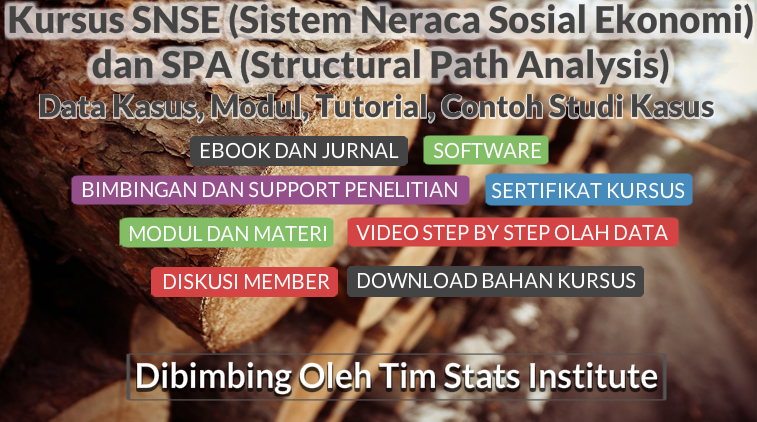











 ======
======
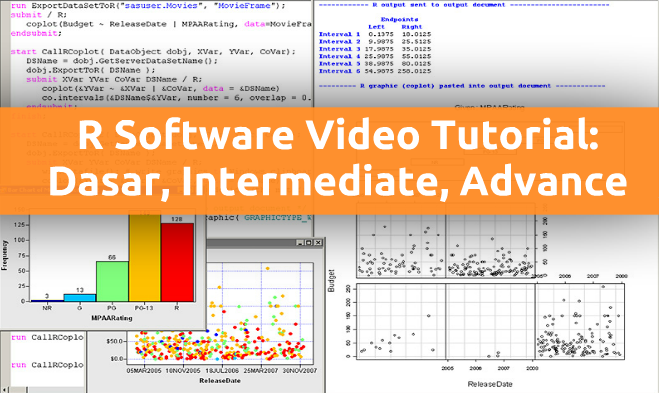












 ---
---

Tidak ada komentar:
Posting Komentar